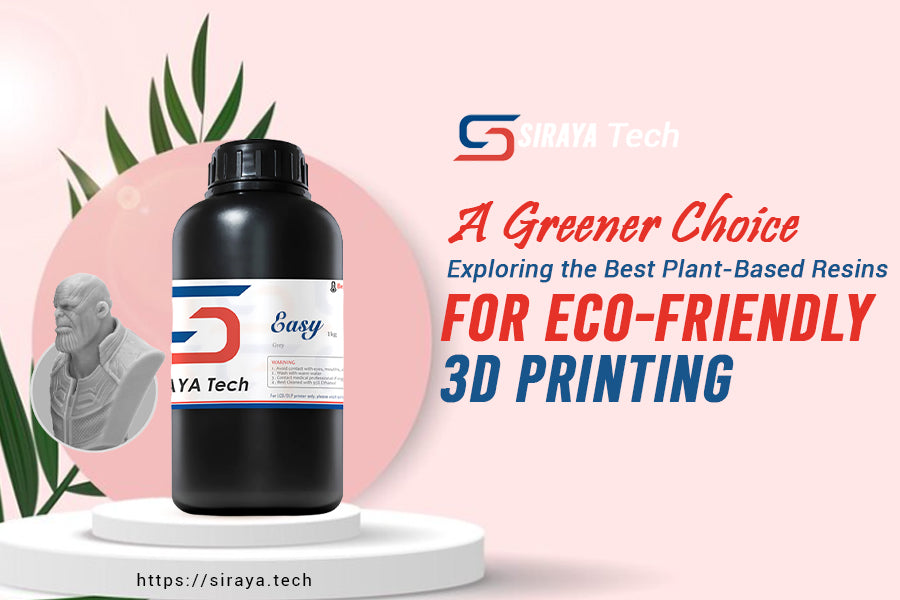製造業と創造性が織りなす魅惑の世界へようこそ。今、脚光を浴びている革新的な技術、3Dプリンティングにスポットライトを当てます。この独創的なプロセスは、愛好家やエンジニアからアーティストやイノベーターまで、幅広い層を魅了しています。「アディティブ・マニュファクチャリング」とも呼ばれるこの技術は、オブジェクトを層ごとに丹念に組み立て、デジタル設計図に驚異的な精度を吹き込みます。まるで夢を現実にするかのようです。3Dプリンティングの用途は、初期のプロトタイプや製品開発から、オーダーメイドの医療用インプラント、精巧な建築模型まで、実に多岐にわたります。
しかし、3Dプリントの人気が高まる一方で、その有望な可能性を覆す深刻な懸念が浮上しています。それは、使用する材料に起因する環境への影響です。従来の環境に優しい3Dプリント用樹脂は、主に石油由来の材料を原料としていますが、生分解性がないことから懸念が広がり、世界的なプラスチック問題の大きな要因となっています。3Dプリント業界が急成長を続ける中で、こうした懸念はさらに深まり、私たちが期待する品質と有用性を損なうことなく、環境に配慮した方向へと導く持続可能な代替材料の模索が加速しています。
植物由来樹脂という概念が登場し、環境に配慮するクリエイターにとって明るい兆しとして登場しました。バイオ樹脂とも呼ばれるこれらの素材は、大豆、サトウキビ、トウモロコシなどの再生可能な資源から得られます。3Dプリント用のこれらの植物由来樹脂は、環境に優しい印刷のあり方を大きく変える可能性を秘めています。これは、個人や企業があらゆる生産分野で持続可能な慣行を採用したいと考えているこの時期に、非常に役立ちます。
3Dプリンティングが無限の創造性と革新性を促進するだけでなく、よりクリーンで環境に優しい地球の実現にも貢献する世界を想像してみてください。このブログでは、この大きな変化を包括的に探求していきます。私たちの旅は、3Dプリンティングの台頭の核心へと私たちを導き、従来の樹脂が複雑に絡み合う環境への影響を解き明かしていきます。そして、地平線上には、elegooの植物由来3Dプリンター樹脂が秘めている、積層造形の世界を大きく変える可能性が秘められているのです。この啓発的な冒険に、ぜひあなたもご参加ください。共に、3Dプリンティングのより持続可能な未来を追求する中で、無限の機会と未開拓の可能性を解き明かしましょう。さあ、共にこの探求に乗り出しましょう。
環境に優しい3Dプリント樹脂について
環境に優しい樹脂による環境負荷の低減
環境の持続可能性が世界的に最重要課題となっている現代において、製造プロセスが環境に与える影響への対応は不可欠です。そこで登場するのが、環境に優しい3Dプリント用樹脂です。これは、積層造形におけるカーボンフットプリントの最小化に向けた重要な一歩です。従来の石油由来の樹脂とは異なり、これらの樹脂は、循環型経済の原則に沿った、より持続可能なソリューションを提供します。
環境に優しい樹脂の選定基準
環境に優しい3Dプリント用樹脂への移行には、そのプラス効果に寄与するいくつかの重要な基準を綿密に評価する必要があります。特に精査される重要な要素の一つは生分解性です。これは、物質が自然に分解し、環境に再び溶け込み、害を及ぼすことなく機能する性質です。従来の樹脂が数十年にわたって生態系に残留するのとは対照的に、elegooの植物由来3Dプリンター用樹脂製品は、一時的な効果をもたらす可能性があり、長期的な汚染への懸念を和らげます。
さらに、これらの樹脂の再生可能な原料は、環境適合性の基盤となっています。トウモロコシやサトウキビといった、栽培によって永続的に再生可能な資源を活用することで、これらの材料の生産は持続可能なものとなり、有限な化石燃料の制約に縛られることなく持続可能です。このアプローチは、生態系のバランスを維持するだけでなく、資源枯渇の脅威からも保護します。
さらに、これらの樹脂の再生可能な資源調達も、環境への配慮のもう一つの柱です。トウモロコシやサトウキビといった栽培によって再生可能な資源を原料とすることで、有限の化石燃料に依存しない持続可能な生産を実現しています。
低臭性樹脂:快適で室内に優しい選択肢
3Dプリント用の環境に優しい樹脂は、環境面でのメリットに加え、ユーザーと室内環境の健康にも配慮しています。特に重要なのは低臭性で、プリントプロセス中のユーザーの快適性を高めます。従来の樹脂には、強烈で時に不快な臭いを発するという共通の課題があります。これらの臭いは不快感を引き起こすだけでなく、密閉された空間で吸い込むと健康への懸念を引き起こす可能性があります。
一方、最高の低臭性樹脂は、はるかにユーザーフレンドリーな体験を提供します。強烈な悪臭と大気汚染の両方の原因となる揮発性有機化合物(VOC)の放出を効果的に最小限に抑えます。そのため、住宅、職場、教育機関など、屋内での3Dプリント環境に最適です。有害な煙が出ないことは、より快適なプリント体験を保証するだけでなく、環境と人々の幸福を包含するサステナブルデザインの価値観にも調和します。ユーザーの利便性と環境意識の融合は、低臭性樹脂が3Dプリントの未来を担う重要な構成要素となる可能性を秘めていることを示唆しています。
環境に優しい3Dプリント樹脂の領域を深く掘り下げていくと、その選択は単なる材料選択にとどまらないことが明らかになります。よりクリーンな地球環境に貢献すると同時に、より健康的で快適なワークスペースを実現するための意識的な決断なのです。生分解性、再生可能原料、そして低臭性といった特性を統合することで、積層造形プロセスを変革するだけでなく、責任あるイノベーションへのコミットメントも反映しています。このブログの以降のセクションでは、植物由来の従来の環境に優しい3Dプリント樹脂が、これらの原則をどのように体現し、3Dプリントの世界における持続可能な進歩の先駆けとなっているのかを探っていきます。
植物由来樹脂の台頭
植物由来樹脂の定義:生分解性と再生可能性
植物由来樹脂の登場は、3Dプリントの世界において、より持続可能な素材への大きな転換を示しています。これは、石油化学由来の従来の樹脂とは異なります。バイオ樹脂は、大豆、サトウキビ、トウモロコシなどの資源から調達できます。この材料構成の根本的な変化は、プラスチック廃棄物による環境負荷の軽減と、有限な化石燃料への依存度の低減という2つの大きな可能性を秘めています。
これらの3Dプリント用植物由来樹脂の最大の特徴は、生分解性です。廃棄または処分された場合でも、植物由来樹脂は時間の経過とともに自然に分解され、汚染の痕跡を残すことなく地球に戻ります。これは、数百年もの間環境に残留し、広範囲にわたるプラスチック汚染危機の一因となっている従来のプラスチックとは対照的です。
3Dプリントにおける植物由来樹脂の利点
3Dプリンティングの分野に植物由来樹脂を取り入れることで、環境保護や持続可能性といった理念と効果的に調和する数多くのメリットが生まれます。中でも特に際立ったメリットは、製造に伴うカーボンフットプリントの顕著な削減です。従来の樹脂製造は有限の化石燃料に大きく依存しており、温室効果ガスの排出と気候変動に大きく寄与しています。これとは対照的に、植物由来樹脂の製造は再生可能な資源を活用し、生態系への影響を効果的に抑制し、より持続可能な製造プロセスへの道を切り開きます。この変化は、地球の健全性への配慮と、責任ある生産と消費の原則を反映したものです。
さらに、植物由来樹脂は、資源を再利用・再生するという循環型経済の精神にも合致しています。トウモロコシやサトウキビなどの作物をこれらの樹脂の原料として使用することで、農業廃棄物を有用な材料に変換できる閉ループシステムが構築され、埋立地への負担を軽減し、天然資源の枯渇を最小限に抑えることができます。
Elegoo:植物由来樹脂ムーブメントの先駆者
植物由来樹脂ムーブメントの最前線に立つ有力企業の一つがElegooです。環境に配慮したイノベーションへのコミットメントに基づき、Elegooは植物由来素材の可能性を最大限に引き出し、性能を損なうことなく持続可能性を重視した幅広い樹脂オプションを提供しています。同社の植物由来樹脂ラインナップは、技術の進歩と環境への責任を融合させる可能性を実証しています。
Elegooは、高品質な植物由来樹脂の開発に注力しており、業界の先駆者としての役割を担っています。3Dプリント愛好家や専門家に持続可能な素材を提供することで、Elegooは彼らがより環境に優しい未来の実現に貢献できるよう支援しています。機能的なプロトタイプから精巧な芸術作品まで、Elegooの植物由来樹脂は、地球資源を保護しながら3Dプリントの可能性を最大限に引き出すバイオレジンの有効性を実証しています。
植物由来樹脂の台頭を目の当たりにする中、積層造形(AM)の世界は持続可能性に向けた変革期を迎えています。Elegooのような先駆者たちによる生分解性、再生可能性、そして革新性への取り組みは、技術の創意工夫と環境への配慮の融合を体現しています。以下のセクションでは、Elegooの植物由来3Dプリンター用樹脂製品の詳細を解説し、それらが環境に優しい3Dプリントの価値をどのように体現しているかを明らかにしていきます。
Elegooの植物由来樹脂を探る
Elegooの環境に優しい取り組み:持続可能な印刷の先駆者
3Dプリントのダイナミックな進化の中で、Elegooは環境に配慮した創意工夫の先駆者として台頭してきました。揺るぎない環境保護への取り組みを基盤に、同社は積層造形に対する私たちの認識を一変させる持続可能なソリューションを導入することで、輝かしい道を切り開いてきました。3Dプリントの環境への影響を軽減するというElegooの揺るぎないコミットメントは、植物由来樹脂の幅広いラインナップに体現されており、より持続可能な未来への彼らの強い思いを具体的に体現しています。
Elegooの植物由来樹脂ラインのご紹介
Elegooの植物由来樹脂製品ラインは、綿密な研究開発と持続可能性への真摯な取り組みの成果です。これらの樹脂は、トウモロコシやサトウキビなどの再生可能な原料を用いて製造されており、循環型経済と資源保全の原則に合致しています。従来の樹脂がもたらす環境問題への直接的な対応として、Elegooの植物由来3Dプリンター用樹脂製品は、技術と環境への責任の間のギャップを埋める効果的なソリューションを提供します。
Elegooの植物由来樹脂の際立った利点の一つは、環境への影響を大幅に低減できることです。生分解性と再生可能資源の調達を採用することで、これらの樹脂は3Dプリント材料に典型的に伴って発生する長期的な汚染を劇的に削減する可能性を秘めています。この転換は、差し迫った環境問題への対応だけでなく、プラスチック廃棄物の削減と貴重な資源の保全という、より広範な取り組みにも貢献します。
妥協のない高品質印刷
Elegooのサステナビリティへの取り組みは、最高水準の印刷品質の提供というコミットメントとシームレスに一体化しています。環境への配慮は最優先事項ですが、3Dプリントの世界ではパフォーマンスを犠牲にしてはならないことをElegooは理解しています。Elegooの植物由来樹脂は、卓越した印刷品質と環境に優しい製造プロセスという、両方の長所を兼ね備えています。ユーザーは、Elegooが誇る高い精度、ディテール、そして一貫性を期待できると同時に、より持続可能な3Dプリントエコシステムの構築にも貢献します。
多彩な可能性
Elegooの植物由来樹脂製品ラインは、サステナビリティへの配慮だけでなく、鮮やかな色彩と仕上がりのバリエーションも豊富に取り揃えています。濃厚で大胆な色合いから繊細なパステルカラーまで、幅広い選択肢をご用意しており、様々なクリエイティブな活動にマッチします。精巧なジュエリー、建築模型、機能的なプロトタイプなど、Elegooの植物由来で環境に優しい3Dプリント用樹脂は、プロジェクトに視覚的な魅力と倫理的な価値を融合させる力となります。
Elegooの植物由来樹脂分野への進出は、技術革新と環境保護の調和のとれた共存を体現しています。3Dプリントコミュニティにとって、持続可能な選択肢を身近で魅力的なものにすることで、Elegooは業界にとって称賛に値する先例を築いています。Elegooの植物由来樹脂製品の詳細を詳しく見ていく中で、これらの樹脂が3Dプリントのより持続可能で責任ある、刺激的な未来を形作る上で、多様な用途と現実世界への影響を明らかにしていきます。
植物由来樹脂と従来の樹脂の比較
グリーンシフト:植物由来樹脂 vs. 石油由来樹脂
持続可能な慣行への要請が業界全体に広がる中、3Dプリンティングの世界は、使用する材料の環境への影響を評価するという岐路に立たされています。一方では、複雑な3Dプリント物を作成する上で、その汎用性と精度の高さから長年高く評価されてきた従来の石油由来樹脂があります。他方では、付加製造における環境負荷の軽減を目指す持続可能な代替材料として、植物由来樹脂が台頭しています。
生分解性と環境への配慮
生分解性と環境への配慮という点において、植物由来樹脂と石油由来樹脂の間には明確な違いがあります。植物由来樹脂の核となるのは、再生可能な生物由来原料から作られているという点です。この大きな違いこそが、持続可能性の向上への道筋を示しています。
バイオ樹脂と呼ばれるこれらの素材は、生分解性を有し、時間の経過とともに自然に分解する性質を持っています。この優れた特性は、プラスチック廃棄物が環境に及ぼす影響を大幅に軽減します。一方、従来の樹脂は化石燃料を原料としており、何世紀にもわたって私たちの周囲に残留し、汚染の原因となり、生態系に脅威を与えています。この対照的な状況は、地球の健全性と生態系のバランスを守るための一歩として、バイオ樹脂を選択することがもたらす変革の可能性を強調しています。
排出量と環境への影響の削減
従来の樹脂の生産は石油に大きく依存しており、そのプロセスは多大な温室効果ガスを排出し、気候変動に寄与しています。一方、再生可能な作物から得られる植物由来樹脂は、排出量を大幅に削減し、よりカーボンニュートラルな選択肢となります。植物由来樹脂を選択することにより、3Dプリンティング業界は従来の製造プロセスがもたらす環境問題の緩和に貢献することができます。
トレードオフのバランス:印刷品質とコスト
植物由来樹脂への移行は環境面でのメリットを期待させる一方で、潜在的なトレードオフを考慮することも不可欠です。特に注目されるのは印刷品質です。従来の樹脂は、高精度で精緻な出力で知られる信頼性の高い素材として確立されています。植物由来樹脂の技術が進化するにつれ、メーカーは印刷品質のギャップを埋めるために熱心に取り組んでおり、環境への配慮が最終製品の完全性を損なわないよう努めています。
コストも重要な要素です。植物由来樹脂、特に再生可能資源由来の樹脂の製造には、より複雑な工程が必要となる場合があり、価格に影響を与える可能性があります。従来の樹脂は、長年の使用と製造方法により、現時点ではより費用対効果の高い選択肢となる可能性があります。しかし、持続可能な代替品への需要が高まるにつれて、規模の経済性と製造におけるイノベーションによって、このコスト差は縮小する可能性があります。
より環境に配慮した選択肢を模索する中で、植物由来樹脂と従来の樹脂の並置は、均衡という重要な概念を浮き彫りにしています。植物由来樹脂は、持続可能性、生分解性、そして排出量の削減という点で大きな可能性を秘めていますが、同時に、それなりの課題も抱えていることを認識することが重要です。印刷品質とコストに関する問題への対処は、その普及において極めて重要です。技術の進歩と意識の高まりに伴い、積層造形業界は今、今日の選択が未来の世代に波及し、私たちの製造、創造、そして地球の保全のあり方を形作る重要な岐路に立っています。
環境に優しい3Dプリントに最適な低臭性植物由来樹脂
低臭気で環境に優しい選択肢を探る
環境に優しい3Dプリントを追求する上で、しばしば見落とされがちな重要な要素の一つが、プリント環境そのものです。従来の樹脂はプリント中に強い臭いを発するため、屋内でのプリントは不快なだけでなく、時には危険を伴うこともあります。そこで、 最高の低臭性樹脂が活躍します。低臭性樹脂は、持続可能性に配慮するだけでなく、快適でユーザーフレンドリーなプリント体験を実現するソリューションを提供します。それでは、現在市場で入手可能な優れた低臭性植物由来樹脂をいくつか見ていきましょう。
樹脂A: PristinePrint BioLite
主な機能と利点:
- 低臭性: PristinePrint BioLiteは、ユーザーの快適性を重視して設計されており、印刷プロセス中の臭いを最小限に抑えています。そのため、空気の質を損なうことなく屋内での使用に適しています。
- 印刷品質:ユーザーからは、非常に優れたディテールと層密着性を備えた高品質の印刷が報告されています。
- 生分解性:再生可能な資源から得られる BioLite は生分解性があり、従来の樹脂に代わる持続可能な代替品を提供します。
- 互換性: BioLite は幅広い 3D プリンターと互換性があり、多様なユーザーが利用できます。
- ユーザーレビュー: BioLiteは、使いやすさ、臭いの少なさ、そして優れた印刷結果が好意的に評価されています。また、環境に優しい点や、倫理的・環境的価値観に合致している点も高く評価されています。
樹脂B:グリーンプリントエコレジン
主な機能と利点:
- 低臭性: GreenPrint EcoResin は低臭性なので、密閉された空間での印刷に最適です。
- 滑らかな仕上がり:この樹脂は滑らかで均一な仕上がりを実現し、機能的なプロトタイプと芸術的な作品の両方に適しています。
- 再生可能な調達:持続可能な方法で調達された植物由来の材料から作られた EcoResin は、3D プリントの二酸化炭素排出量の削減に貢献します。
- 互換性:さまざまな 3D プリンターとの互換性により、ユーザーは EcoResin を既存のセットアップにシームレスに統合できます。
- ユーザーレビュー: EcoResinの強い臭いのなさや印刷品質は高く評価されています。パフォーマンスを最適化するには、印刷設定を少し調整する必要があると指摘するユーザーもいます。
樹脂C: BioInvent HarmonyPrint
主な機能と利点:
- 低臭性: HarmonyPrint は実質的に無臭であり、快適な印刷体験を保証します。
- 高解像度: HarmonyPrint を使用すると、複雑で非常に詳細な印刷を実現できるとユーザーから報告されています。
- 生分解性:植物由来の素材で作られた HarmonyPrint は生分解性があり、よりクリーンな環境に貢献します。
- 使いやすさ:この樹脂は、取り扱いが簡単で、さまざまな 3D プリンターと互換性があることで知られています。
- ユーザーレビュー: HarmonyPrintの優れた印刷品質、強い臭いのなさ、そして使いやすさがレビューで高く評価されています。最適な結果を得るために、硬化時間を試してみることを勧めるユーザーもいます。
環境に優しい3Dプリントソリューションの需要が高まる中、低臭性の植物由来樹脂の登場により、より快適で持続可能なプリント体験への扉が開かれています。ここで紹介した樹脂はそれぞれ、優れたプリント品質から互換性、使いやすさまで、独自のメリットを備えています。ユーザーレビューで得られる実際の知見は、各樹脂の実用的なメリットと考慮すべき点を理解するのに役立ちます。アーティスト、エンジニア、趣味のユーザーなど、誰にとっても、従来の環境に優しい3Dプリント樹脂製品の登場は、品質や室内空気質を損なうことなく、より環境に優しい選択肢をもたらします。
植物由来樹脂を使ったプリントを成功させるためのヒント
植物由来樹脂への移行
3Dプリントプロジェクトで植物由来樹脂に切り替えることは、環境への責任を果たすための素晴らしい一歩です。これらの樹脂は、プリントに期待される品質と精度を維持しながら、より環境に優しい代替品を提供します。スムーズな移行と最適な結果を得るために、考慮すべき実用的なヒントをいくつかご紹介します。
- 印刷設定を調整する
植物由来樹脂は幅広い3Dプリンターで使用できるように設計されていますが、使用する樹脂の特性に合わせて印刷設定を調整することをお勧めします。積層高さ、露光時間、印刷速度などのパラメータに注意してください。ほとんどのメーカーは樹脂の推奨設定を提供しており、調整の出発点として役立ちます。
- 露出時間の実験
3Dプリント用の植物由来の環境に優しい樹脂は、従来の樹脂と比べて露光時間が若干異なる場合があります。まずはメーカーの推奨値を参考に、少量のテストプリントを行い、ご自身の印刷環境に合わせて露光設定を微調整してください。この反復的なアプローチにより、印刷品質と硬化時間の最適なバランスを実現できます。
- 硬化プロセスの監視
硬化プロセスは、プリントの最終的な強度と耐久性に重要な役割を果たします。印刷後は、メーカーのガイドラインに従って後処理と硬化を行ってください。UV硬化チャンバーや日光照射は、樹脂を適切に固めるのに役立ちます。硬化が不十分なパーツは機械的特性が低下する可能性があるため、徹底的かつ均一に硬化させるようにしてください。
- 樹脂を適切に扱う
植物由来の樹脂は、他の樹脂と同様に、取り扱いには十分ご注意ください。樹脂を取り扱う際は、手袋や安全ゴーグルなどの適切な保護具を着用してください。こぼれに注意し、廃棄物は地域の条例に従って環境に配慮した方法で処分してください。
- 換気と印刷環境
最高品質の低臭性樹脂は従来の樹脂よりも煙の発生が少ないですが、それでもプリントエリアの換気を良好に保つことをお勧めします。残留臭を放散し、空気中の微粒子への曝露を最小限に抑えるために、適切な空気の流れを確保してください。
課題と解決策
課題:接着と反り
植物由来のレジンは、従来のレジンとは接着性が若干異なる場合があります。この問題を解決するには、プリント前に必ずビルドプラットフォームが適切に水平調整され、清掃されていることを確認してください。また、接着層や特殊なビルド面を使用することで、接着性が向上し、反りのリスクを軽減できます。
課題:印刷品質
植物由来の樹脂で希望通りの印刷品質を得るには、ある程度の試行錯誤が必要になるかもしれません。露光時間、積層ピッチ、印刷速度などの設定をいろいろと試して、お使いの樹脂に最適な設定を見つけてください。
課題:硬化の一貫性
硬化が不均一だと、プリントの一部が弱くなる可能性があります。硬化プロセス中は、プリントを回転させたり、位置を変えたりして、すべての面に十分な紫外線が当たるようにしてください。
これらのヒントを実践し、学習プロセスを辛抱強く続けることで、3Dプリントにおける植物由来樹脂の潜在能力を最大限に引き出すことができます。3Dプリントにおいて植物由来樹脂のような持続可能な素材への移行は、環境に優しいだけでなく、よりクリーンな良心を持って創作活動を行うことを可能にします。
結論
3Dプリントの世界は絶えず進化を続けており、植物由来樹脂の登場は、より持続可能で環境に配慮した未来への大きな一歩となります。環境に優しい3Dプリントの世界を探るこの特集を締めくくるにあたり、重要なポイントを振り返り、このダイナミックな業界において、より環境に配慮した選択を積極的に行うことの重要性を強調したいと思います。
より環境に優しい未来への道
植物由来樹脂は、従来の3Dプリント材料に伴う環境問題に対する有望な解決策となります。生分解性、再生可能資源、そしてカーボンフットプリントの削減といった特徴を持つ植物由来樹脂は、プラスチック汚染や有限資源の枯渇といった問題への取り組みにおいて、持続可能性の象徴となっています。elegooの植物由来樹脂を選択することで、材料を廃棄するのではなく再生し、プラスチック廃棄物の長期的な影響を最小限に抑える循環型経済に貢献します。
環境への影響の軽減
3Dプリント業界は急速に拡大しており、その成長に伴い、地球環境への配慮に対する責任も増大しています。植物由来樹脂を採用することで、メーカー、クリエイター、そして愛好家は、自らの活動による環境への影響を積極的に軽減することができます。排出量の削減、持続的なプラスチック廃棄物の排除、そしてより健康的な屋内プリント環境の創出は、いずれも正しい方向への一歩です。
植物由来樹脂の探求:次のステップ
今後の3Dプリントプロジェクトをご検討の際は、植物由来樹脂があなたの創作活動にもたらすプラスの影響についてご検討ください。これらの樹脂は、倫理的・環境的価値を体現するだけでなく、品質、精度、そして革新性も兼ね備えています。幅広い用途に対応し、様々な3Dプリンターとの互換性も備えた植物由来樹脂は、原理を損なうことなく、汎用性も兼ね備えています。
植物由来の樹脂を印刷ツールキットに取り入れることで、環境に優しい選択のメリットを享受しながら、目に見える変化をもたらすことができます。二酸化炭素排出量の削減から未来の世代へのポジティブな遺産の継承まで、環境に優しい3Dプリントの道はあなたを待っています。良心を持ってイノベーションを受け入れ、あなたの作品にテクノロジーとサステナビリティの調和を体現させましょう。
3Dプリントのベテランの方でも、この刺激的な旅に初めて足を踏み入れたばかりの方でも、一歩踏み出し、植物由来樹脂を使った3Dプリントの世界を探求し、より環境に配慮した責任ある未来を形作る変革の一翼を担ってください。あなたのプリント、あなたの選択、そしてあなたが及ぼす影響は重要です。植物由来樹脂を使えば、より環境に優しい世界を、一枚一枚積み重ねながら形作ることができるのです。


1 コメント
bio
You should discuss aspects regarding compostability and biodegradability of these resins, since plant-based resins are not necessarily compostable (which PLA can be).